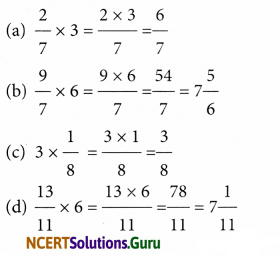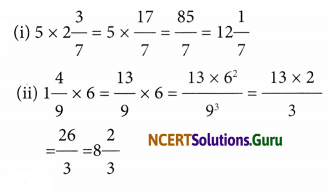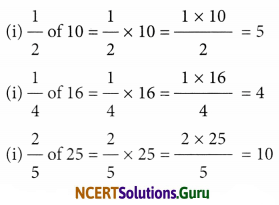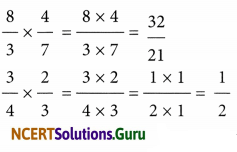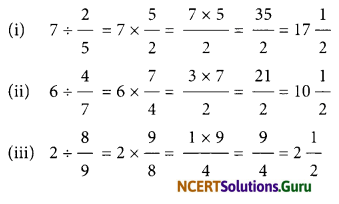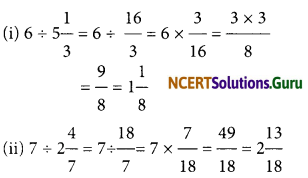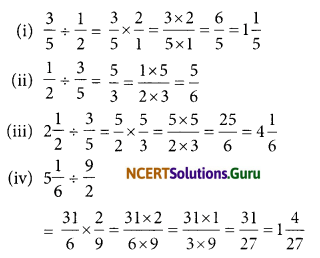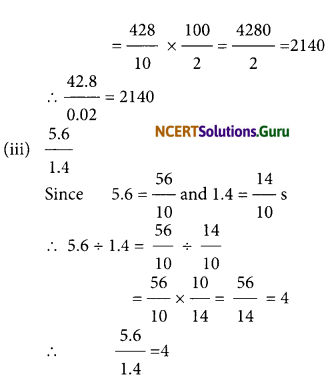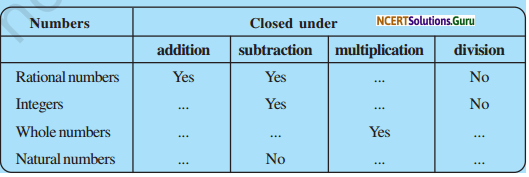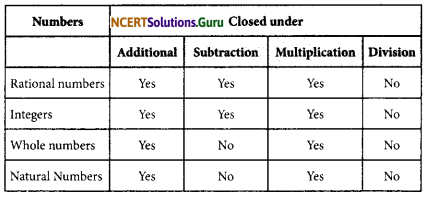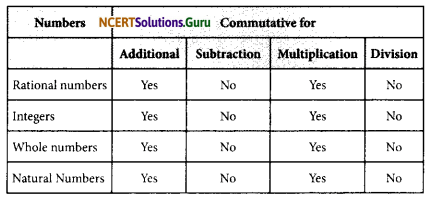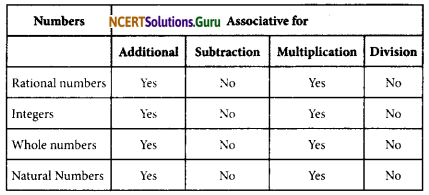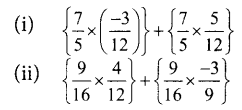NCERT Solutions for Class 7 Maths Chapter 13 Exponents and Powers InText Questions
These NCERT Solutions for Class 7 Maths Chapter 13 Exponents and Powers InText Questions and Answers are prepared by our highly skilled subject experts.
NCERT Solutions for Class 7 Maths Chapter 13 Exponents and Powers InText Questions
NCERT In-text Question Page No. 250
Question 1.
Find five more such examples, where a number is expressed in exponential form. Also identify the base and the exponent in each case.
Answer:
| Number | Exponential form | Base | Exponent |
| (i) 243 = 3 × 3 × 3 × 3 × 3 | 35 | 3 | 5 |
| (ii) 625 = 5 × 5 × 5 × 5 | 54 | 5 | 4 |
| (iii) 343 = 7 × 7 × 7 . | 73 | 7 | 3 |
| (iv) 1331 = 11 × 11 × 11 | 113 | 11 | 3 |
| (v) 64 = 8 × 8 | 82 | 8 | 2 |
Note: 1. xxxxxxx = x4is read as ‘x raised to the power 4’ or ‘4th power of x’.
2. x2y5 is read as ‘x squared into y raised to power 5’.
3. p6q3 is reas as ‘p raised to the power 6 into q cubed’.
![]()
NCERT In-text Question Page No. 251
Question 1.
Express:
(i) 729 as a power of 3
(ii) 128 as a power of 2
(iii) 343 as a power of 7
Answer:
(i) 729
We have: 729 = 3 × 3 × 3 × 3 × 3 × 3 = 36
Thus, 729 = 36
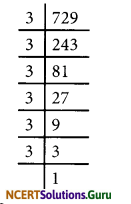
(ii) 128
We have: 128 = 2 × 2 × 2 × 2 × 2 × 2 × 2 = 27
Thus, 128 = 27
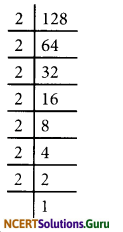
(iii) 343
We have: 343 = 7 × 7 × 7 × 7= 73
Thus, 343 = 73

NCERT In-text Question Page No. 254
Question 1.
Simplify and write in exponential form:
(i) 25 × 23
(ii) p3 × p2
(iii) 43 × 42
(iv) a3 × a2 × a7
(v) 53 × 57 × 512
(vi) (-4)100 × (-4)20
Answer:
(i) 25 × 23
We have: 25 × 23 = 25 + 3 = 28
![]()
(ii) p3 × p2
We have: p3 × p2 = p3 + 2 = p5
(iii) 43 × 42
We have: 43 × 42<.sup> = 43+2 = p5
(iv) a3 × a2 × a7
We have: a3 × a2 × a7 = a3 + 2 + 7 = a12
(v) 53 × 57 × 512
We have: 53 × 57 × 512 = 53 + 7 + 12 = 522
(vi) (-4)100 × (-4)20
We have: (-4)100 × (-4)20 = (-4)100+2 = (4)120
Note: The above rule is possible only for same bases. It is not true for different bases. Thus, 23 x 32 will no obev this rule.
NCERT In-text Question Page No. 255
Question 1.
Simplify and write in exponential form: (eg., 116 ÷ 112 = 114)
(i) 29 ÷ 23
(ii) 108 ÷ 104
(iii) 911 ÷ 97
(iv) 2015 ÷ 2013
(v) 713 ÷ 710
Answer:
Since am an = am-n, therefore;
(i) 29 ÷ 23
We have: 29 ÷ 23 = 29-3 = 26
![]()
(ii) 108 ÷ 104
We have: 108 ÷ 104 = 108-4 = 104
(iii) 911 ÷ 97
We have: 911 ÷ 97 = 911-7= 94
(iv) 2015 ÷ 2013
We have: 2015 ÷ 2013 = 2015 -13 = 202
(v) 713 ÷ 710
We have: 713 ÷ 710 = 713-10 = 73
Question 15.
Simplify and write the answer in exponential form:
(i) (62)4
(ii) (22)100
(iii) (750)2
(iv) ( 53)7
Answer:
Since (am)n = amxn = amn, therefore;
(i) (62)4
We have: (62)4 = 62 × 4 = 68
(ii) (22)100
We have: ( 22)100 = 22 × 100 = 2200
(iii) (750)2
We have: (750 )2 = 750 × 2 = 7100
(iv) ( 53)7
We have: (53)7 = 53 × 7 = 521
![]()
NCERT In-text Question Page No. 256
Question 1.
Put into another form using am × bm= (ab)m
(i) 43 × 23
(ii) 25 × b5
(iii) a2 × t2
(iv) 56 × (-2)6
(v) (-2)4 × (-3)4
Answer:
Since am ÷ an = am-n, therefore;
(i) 43 × 23
We have: 43 × 23 = (4 × 2)3 = 83
(ii) 25 x b5
We have: 25 × b5 = (2 × b)5= (2b)5
(iii) a2 × t2
We have: a2 x t2 = (a × t)2 = (at)2
(iv) 56 x (-2)6
We have: 56 × (-2)6 = [5 × (-2)]6 = (-10)6
(v) (-2)4 x (-3)4
We have: (-2)4 × (-3)4 = [(-2) × (-3)]4 = (6)4
NCERT In-text Question Page No. 257
Question 2.
Put into another form using am ÷ bm
(i) 45 ÷ 35
(ii) (-2)5 ÷ b5
(iii) (-2)3 ÷ b3
(iv) p4 ÷ q4
(v) 56 ÷ (-2)6
Answer:
(i) 45 ÷ 35
We have: 45 ÷ 35 = \(\left(\frac{4}{3}\right)^{5}\)
(ii) (-2)5 ÷ b5
We have: (-2)5 ÷ b5 = \(\left(\frac{2}{b}\right)^{5}\)
![]()
(iii) (-2)3 ÷ b3
We have: (-2)3 ÷ b3 = \(\left(\frac{-2}{b}\right)^{3}\)
(iv) p4 ÷ q4
We have: p4 ÷ q4 = \(\left(\frac{p}{q}\right)^{4}\)
(v) 56 ÷ (-2)6
We have: 56 ÷ (-2)6 = \(\left(\frac{5}{-2}\right)^{6}\) = \(\left(-\frac{5}{2}\right)^{6}\)
NCERT In-text Question Page No. 261
Question 1.
Expand by expressing powers of 10 in the exponential form:
(i) 172
(ii) 5,643
(iii) 56,439
(iv) 1,76,428
Answer:
(i) 172:
We have:
172 =(1 × 100) + ( 7 × 10) + (2 × 1)
= 1 × 102 + 7 × 101 + 2 × 1)
(∵100 = 1)
(ii) 5,643:
We have:
5,643 = 5 × 1000 + 6 × 100 + 4 × 10 + 3 × 1
= 5 × 103 + 6 × 102 + 4 × 101 + 3 × 100
(iii) 56,439:
We have:
56,439 = 5 × 10000 + 6 × 1000 + 4 × 100 + 3 × 10 + 9 × 1
= 5 × 104 + 6 × 103 + 4 × 102 + 3 × 101 + 9 × 100
![]()
(iv) 1,76,428:
We have:
1,76,428 = 1,00,000 + 7 × 10,000 + 6 × 1000 + 4 × 100 + 2 × 10 + 8 × 1
= 1 × 105 + 7 × 104 + 6 × 103 + 4 × 102 + 2 × 101 + 8 × 100
NCERT Solutions for Class 7 Maths Chapter 13 Exponents and Powers InText Questions Read More »
